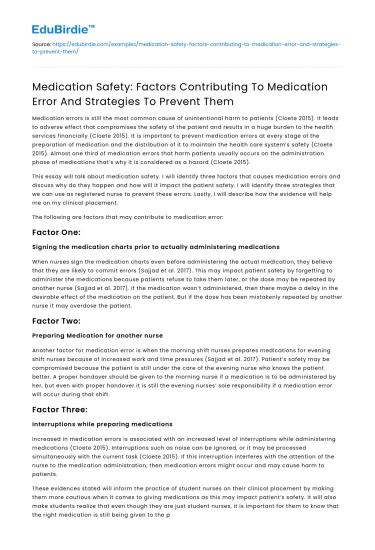Medication errors is still the most common cause of unintentional harm to patients (Cloete 2015). It leads to adverse effect that compromises the safety of the patient and results in a huge burden to the health services financially (Cloete 2015). It is important to prevent medication errors at every stage of the preparation of medication and the distribution of it to maintain the health care system’s safety (Cloete 2015). Almost one third of medication errors that harm patients usually occurs on the administration phase of medications that’s why it is considered as a hazard (Cloete 2015).
This essay will talk about medication safety. I will identify three factors that causes medication errors and discuss why do they happen and how will it impact the patient safety. I will identify three strategies that we can use as registered nurse to prevent these errors. Lastly, I will describe how the evidence will help me on my clinical placement.
Save your time!
We can take care of your essay
- Proper editing and formatting
- Free revision, title page, and bibliography
- Flexible prices and money-back guarantee
The following are factors that may contribute to medication error:
Factor One:
Signing the medication charts prior to actually administering medications
When nurses sign the medication charts even before administering the actual medication, they believe that they are likely to commit errors (Sajjad et al. 2017). This may impact patient safety by forgetting to administer the medications because patients refuse to take them later, or the dose may be repeated by another nurse (Sajjad et al. 2017). If the medication wasn’t administered, then there maybe a delay in the desirable effect of the medication on the patient. But if the dose has been mistakenly repeated by another nurse it may overdose the patient.
Factor Two:
Preparing Medication for another nurse
Another factor for medication error is when the morning shift nurses prepares medications for evening shift nurses because of increased work and time pressures (Sajjad et al. 2017). Patient’s safety may be compromised because the patient is still under the care of the evening nurse who knows the patient better. A proper handover should be given to the morning nurse if a medication is to be administered by her, but even with proper handover it is still the evening nurses’ sole responsibility if a medication error will occur during that shift.
Factor Three:
Interruptions while preparing medications
Increased in medication errors is associated with an increased level of interruptions while administering medications (Cloete 2015). Interruptions such as noise can be ignored, or it may be processed simultaneously with the current task (Cloete 2015). If this interruption interferes with the attention of the nurse to the medication administration, then medication errors might occur and may cause harm to patients.
These evidences stated will inform the practice of student nurses on their clinical placement by making them more cautious when it comes to giving medications as this may impact patient’s safety. It will also make students realize that even though they are just student nurses, it is important for them to know that the right medication is still being given to the patient because even registered nurses makes mistakes. Being able to practice safe administration of medicines while still in clinical placements will help them be confident nurses in the future.
First strategy:
Single Nurse Administration
The safest option of medication administration in most adult hospital setting is one nurse administering the medication (Boyd 2013). It is because the nurse will take extra care because it is their sole responsibility (Boyd 2013). It is always safe to double check the medications with another nurse, but this only applies to injected drugs and controlled drugs, it also needs to be signed by two nurses and be administered at the patient’s bedside (Boyd 2013).
Second strategy:
Five Rights Principle
Nurses must ensure that they check the five rights of medication administration regardless of the administration route and check it three times when administering any medication (Levett-Jones 2017). To help ensure that this important steps in the process are not overlooked they need to follow this sequential and logical approach to promote patient safety and prevent medication errors (Levett-Jones 2017).
Third strategy:
Medication safety courses
To provide an early insight for future nurses to action change in the practice of drug administration, medication safety courses should be taken by undergraduate nursing students (Edwards 2018). Being a competent nurse in the future in terms of providing medication safety starts on our student placements. As student nurses, it is important that we comply with all the medication safety courses being given to us before going on our placements as this will be beneficial for us by it providing the information that is essential in preventing medication errors.
References:
- Boyd, C. (ed.) 2013, ‘Medicine Management Skills for Nurses’, Student Survival Skills, A John Wiley & Sons, Ltd., New Jersey, USA.
- Cloete, L. 2015, ‘Reducing Medication Errors in Nursing Practice’, Nursing Standard, vol. 29, Iss 20.
- Edwards, S.L. & Axe, S. 2018, 'Medication management: Reducing drug errors, striving for safer practice', Nurse Prescribing, vol. 16, no. 8, pp. 385.
- Levett-Jones, T. 2017, ‘Medication Administration’, in A. Berman, S. Snyder, T. Levett-Jones, P. Burton & N. Harvey (eds.), Skills in Clinical Nursing, Pearson Australia, Melbourne, VIC, p 247.
- Sajjad, S., Gowani, A., Kazmi, A., Mansoor, S. 2017, ‘Factors contributing to medication errors in a Tertiary Care Private Hospital, Karachi’, i-Manager’s Journal on Nursing; Nagercoil, vol. 7. Iss. 3.






 Stuck on your essay?
Stuck on your essay?

